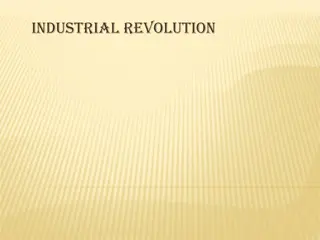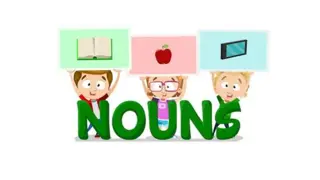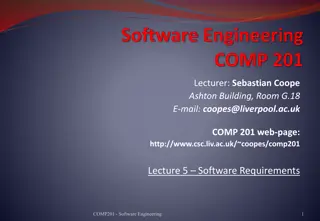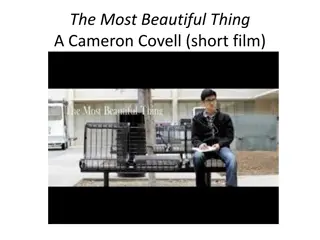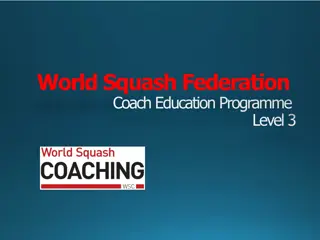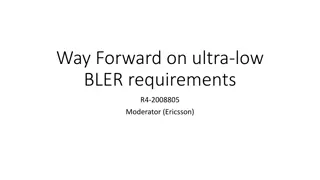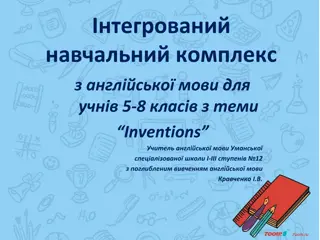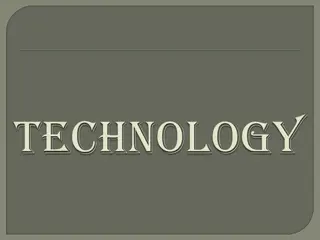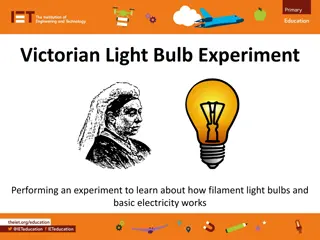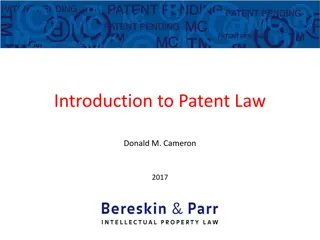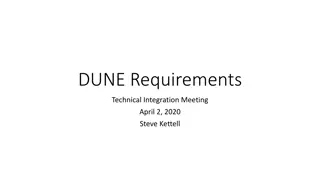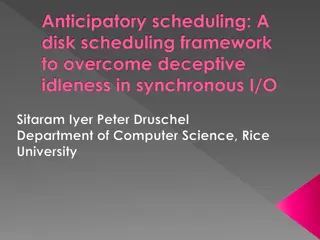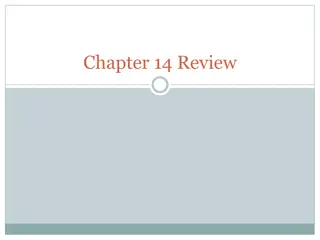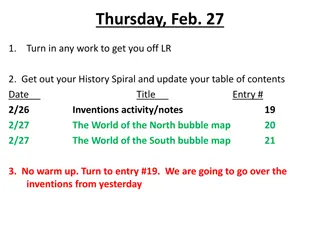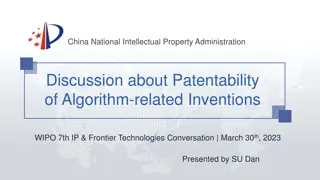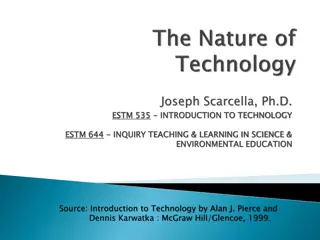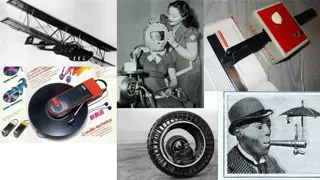Understanding Patentable Inventions: Requirements and Anticipation
Patentable inventions must be new, useful, and inventive. Anticipation plays a crucial role in determining patent validity, requiring clear claims and not covering old or useless ideas. The Canadian legal perspective on anticipation and old patent definitions provide insights into establishing the novelty of an invention. The process of staking a claim for a patent involves delineating boundaries of monopoly rights with precision to notify the public and prevent trespassing. The importance of clear, unambiguous claims in patents is emphasized to avoid ambiguity and ensure the protection of genuine innovations.
Download Presentation

Please find below an Image/Link to download the presentation.
The content on the website is provided AS IS for your information and personal use only. It may not be sold, licensed, or shared on other websites without obtaining consent from the author. Download presentation by click this link. If you encounter any issues during the download, it is possible that the publisher has removed the file from their server.
E N D
Presentation Transcript
Anticipation May 30, 2023 Don Cameron Donald M. Cameron
Whats a patentable invention need to be? New Useful Inventive 2
Anticipation = 1 shot Anticipation is deadly but requires the accuracy of a sniper, not the firing of a 12 gauge shotgun. Apotex Pty Ltd (formerly GenRx Pty Ltd) v Sanofi-Aventis [2008] FCA 1194 per Gyles J.
The sunspot analogy, contd Key: Black umbra : what s old 4
Staking a Claim "By his claims the inventor puts fences around the fields of his monopoly and warns the public against trespassing on his property. His fences must be clearly placed in order to give the necessary warning and he must not fence in any property that is not his own. The terms of a claim must be free from avoidable ambiguity or obscurity and must not be flexible; they must be clear and precise so that the public will be able to know not only where it must not trespass by where it may safely go. If a claim does not satisfy these requirements it cannot stand... The inventor may make his claims as narrow as he pleases within the limits of his invention but he must not make them too broad. He must not claim what he has not invented for thereby he would be fencing off property which does not belong to him. It follows that a claim must fail if, in addition to claiming what is new and useful, it also claims something that is old or something that is useless. Minerals Separation North American Corp. v. Noranda Mines, Ltd., (1947), 12 C.P.R. 99 (Ex.Ct. per Thorson P.) at p. 146. 5
Anticipation old definitions s. 28 s. 28(1) Not known or used by any other person before he invented it;* Not described in any patent or in any publication printed in Canada or in any other country more than two years before presentation of the petition hereunder mentioned; and Not in public use or on sale in Canada for more than two years prior to his application. S. 63* Before the date of application for the patent such other person had disclosed or used the invention in such a manner that it had become available to the public.
Old: Reeves Bros tests 1. give an exact prior description; 2. give directions which will inevitably result in something within the claims ( the infringement test ); 3. give clear and unmistakable directions; 4. give information which for the purpose of practical utility is equal to that given by the subject patent; 5. convey information so that a person grappling with the same problem must be able to say "that gives me what I wish"; 6. give information to a person of ordinary knowledge so that he must at once perceive the invention [without experimentation]; 7. in the absence of explicit directions, teach an "inevitable result" which "can only be proved by experiments"; 8. satisfy all these tests in a single document without making a mosaic.
in a single document, or in a single act
Gibney v. Ford The Ford unit assists in preventing water splash, dirt and oil from entering the rear openings of the generator
Beloit per Hugessen J.A. It will be recalled that anticipation, or lack of novelty, asserts that the invention has been made known to the public prior to the relevant time. The inquiry is directed to the very invention in suit and not, as in the case of obviousness, to the state of the art and to common general knowledge. Also, as appears from the passage of the statute quoted above, anticipation must be found in a specific patent or other published document; it is not enough to pick bits and pieces from a variety of prior publications and to meld them together so as to come up with the claimed invention. One must, in effect, be able to look at a prior, single publication and find in it all the information which, for practical purposes, is needed to produce the claimed invention without the exercise of any inventive skill. The prior publication must contain so clear a direction that a skilled person reading and following it would in every case and without the possibility of error be led to the claimed invention.
2002 Baker Petrolite 1. Sale to the public or use by the public alone is insufficient to prove anticipation. Disclosure of the invention is required to constitute anticipation under paragraph 28.2(1)(a). The disclosure must make the necessary invention available. 2. For a prior sale or use to anticipate an invention, it must amount to "enabling disclosure" so as to make available information as to its contents and its methods of manufacture or to be enabled to make or obtain the invention.
Remember reverse engineering? How do they get the Caramilk in the Caramilk bar?
2002 Baker Petrolite 3. The prior sale or use of a chemical product will constitute enabling disclosure to the public if its composition can be discovered through analysis of the product because direct and unambiguous access to information concerning the composition or internal structure of a prior used product is possible. 4. The analysis must be able to be performed by a person skilled in the art in accordance with known analytical techniques available at the relevant time to find the invention without the use of inventive skill. 5. When reverse engineering is necessary and capable of discovering the invention, an invention becomes available to the public if a product containing the invention is sold to any member of the public who is free to use it as she or he pleases.Communicating the invention to a single member of the public without inhibiting fetter is enough to amount to a making available to the public. The grant of a patent depends on the inventor giving to the public something it did not have before. If the public already has it, then the inventor gives nothing and is not entitled to anything in return, i.e. a monopoly for a period of years. 6. It is not necessary to demonstrate that a member of the public actually analysed the product that was sold in the case or prior use nor read the book or whether it was situated in a dark and dusty corner of the library.
2002 Baker Petrolite 7. The amount of time and work involved in conducting the analysis is not determinative of whether a skilled person could discover the invention. The relevant consideration, in this respect, is only whether inventive skill was required. 8. It is not necessary that the product that is the subject of the analysis be capable of exact reproduction. It is the subject-matter of the patent claims (the invention) that must be disclosed through the analysis. Novelty of the claimed invention is destroyed if there is disclosure of an embodiment which falls within the claim.** A complete analysis of a prior used product so as to enable an exact reproduction of such product is not necessary in order to destroy the novelty of the claimed product. ** Subject to it being enabling
Current Patent Act 28.2 (1) The subject-matter defined by a claim in an application for a patent in Canada (the "pending application") must not have been disclosed (a) before the one-year period immediately preceding the filing date or, if the claim date is before that period, before the claim date by the applicant, or by a person who obtained knowledge, directly or indirectly, from the applicant, in such a manner that the subject-matter became available to the public in Canada or elsewhere; (b) before the claim date by a person not mentioned in paragraph (a) in such a manner that the subject-matter became available to the public in Canada or elsewhere; 15
The claim date The filing date of the application, unless a. There s a previously regularly filed application for the same subject matter: i. In Canada; or ii. In a foreign country that affords similar protection to Canadians; b. The filing date of the pending application is within 12 months after the filing date of the previously regularly filed application; and c. The applicant made a request for priority
Youre too late if: The claim date of a claim in a patent is either the: 1. filing date of the patent; or 2. the filing date of a previously regularly filed application where priority has been properly claimed. A patent application will fail for anticipation if the inventor waited too long to file: He/she disclosed it > 12 mo before claim date; someone else made the invention public before the claim date; or someone else has a co-pending patent application that has an earlier claim date.
What Sanofi said Enabling disclosure 18
What Sanofi said The following non-exhaustive factors should be considered. para. 37: 1. Enablement is to be assessed having regard to the prior patent as a whole including the specification and the claims. There is no reason to limit what the skilled person may consider in the prior patent in order to discover how to perform or make the invention of the subsequent patent. The entire prior patent constitutes prior art. 2. The skilled person may use his or her common general knowledge to supplement information contained in the prior patent. Common general knowledge means knowledge generally known by persons skilled in the relevant art at the relevant time.
What Sanofi said 3. The prior patent must provide enough information to allow the subsequently claimed invention to be performed without undue burden. When considering whether there is undue burden, the nature of the invention must be taken into account. For example, if the invention takes place in a field of technology in which trials and experiments are generally carried out, the threshold for undue burden will tend to be higher than in circumstances in which less effort is normal. If inventive steps are required, the prior art will not be considered as enabling. However, routine trials are acceptable and would not be considered undue burden. But experiments or trials and errors are not to be prolonged even in fields of technology in which trials and experiments are generally carried out. No time limits on exercises of energy can be laid down; however, prolonged or arduous trial and error would not be considered routine. Obvious errors or omissions in the prior patent will not prevent enablement if reasonable skill and knowledge in the art could readily correct the error or find what was omitted. 4. 21
Conclusions since Sanofi Mechanical: The Caramilk bar test If you can see it, you can figure it out Observing isn t experimenting disclose enable 23
Conclusions since Sanofi Chem/Pharma: The Coca-cola test Can t figure out how they made it. disclose enable 24
Dons approach to Anticipation 1. Construe the claim; determine the essential elements; 2. Filter the prior art: 1. > 1 yr before filing date for disclosure by inventor(s) [the self-inflicted wound of waiting too long to apply]; 2. Before claim date for others; 3. Exclude experimental prior art.
Dons approach to Anticipation 3. Sanofi double barrelled questions: 1. Does the 1 prior art reference contain all essential elements of the claim in question? [The old reverse infringement test]; AND 2. Is that disclosure, read with CGK, enabling?
Thank You Don Cameron DCameron@bereskinparr.com Bereskin & Parr LLP




